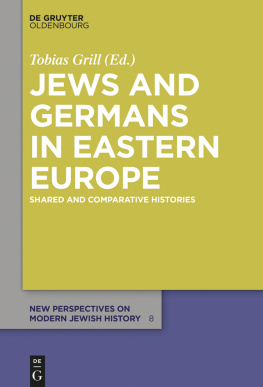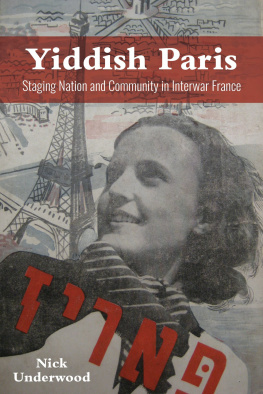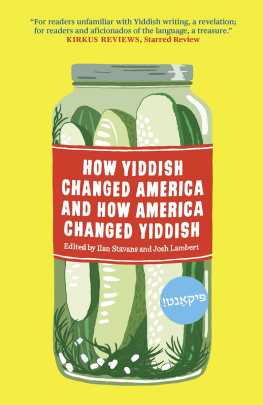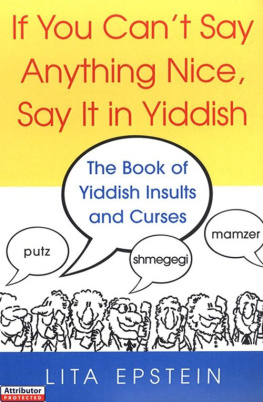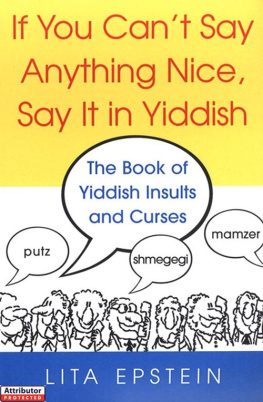1. Steve McQueens first professional line, delivered in a 1952 all-Yiddish production of Molly Picon , played on Knish Alley, Yiddish theaters Broadway.
McQueen [enters, grim look on his face]:
Alles iz forloren.
All is lost.
2. What are you, a meshuggener ? Were all mishpocha !
Jenny McCarthy to Pamela Anderson ( Stacked, the Fox Television sitcom, 2005)
3. That shmendrick keeps looking over here. And that guy has a gun. And you have to do what you have to do.
Harvey Keitel in a mid-2007 Gatorade commercial
4. I would tell you, ladies and gentlemen, how much better you understand Yiddish than you suppose.
Franz Kafka
5. Did someone call me shnorrer ?
Groucho Marx in Animal Crackers (1930)
T o begin to understand the soul of Yiddish, one neednt understand the homely language as much as its bipolar worldview. Mere answers of how this mutt language saved the often fatally stubborn and proud Jews over the last thousand years doesnt begin to tell the full tale of the mamme-loshn (mother tongue) any more than the correct answers on Jeopardy! reveal anything beyond the memorization of trivia.
Over the centuries, experts have thought Yiddish had as many linguistic meanings as the word oy . At various times it was considered a jargon, dialect, vulgar street slang, language, secret code, medium of high art, punishment, Jewish Esperanto, or even an embarrassment to its people. Yet its always been anything but trivial.
Not that Yiddish doesnt bear enough Neat Facts to titillate Alex Trebek. How could it possibly be, for example, that Steve McQueen, Jimmy Cagney, American war hero General Colin Powell, and Nazi war criminal Adolf Eichmann all knew Yiddishwhile few of Israels prime ministers have had even a passing knowledge of the language.
Yet this is not a history of Yiddish, but the story of Yiddish. True, there are names, dates, and places important to the languages development lurking not too deeply in its one-thousand-year history as perhaps the worlds most loathed and loved patois.
These historical truths are critical. Still, this is really the story of how Yiddishs heart and spirit evolved from its status as the worst-ever, quasi-linguistic equivalent of the 1962 New York Mets into, simultaneously, the most sonorous, wisest, ironic, funereal, and joyous language in the world.
Yiddish has forever been granted least-favorite-nation status by the Jews enemies. Never mind that der yidn (Jews), wandering forever in Diaspora, never even were a nation, as they were kicked around like an always-deflating soccer ball in a match of global proportions that was never good for the Jews.
Yet there were good times, many of them, and all reflected in Yiddish. I hope that joy will be captured in these pages; Yiddish is as much about the humor and magic of life as it is about seemingly never-ending pogroms and cataclysm. Many of those laughs have come through clenched teeth and lost hopes. Yet Yiddish, in all of its feeling, longing, and laughter, is available to anyone. You dont have to be Jewish to enjoy Levys rye bread, as in the famous ad read in New York subways; nor do you have to be Jewish to read this book.
In fact it might be better if youre not. Besides gaining a further insight into the Yiddish-based mind of many Jews, there is always the enjoyment that comes with going up to a group of Chasidic or ultra-Orthodox men at a gas pump or convenience store, and begin talking to them in Yiddish.
For Jews, Yiddish is the easiest way to see who we and the world are, and were, to der yidn and der goyim (Gentiles). It is understanding Yiddishkeitthe spirit and essence of living life like a Jewat a time when too many yidn have forgotten or never knew the story of the language that saved them more than any rabbi ever did.
The book can be read out of order, by pages, paragraphs, or sentences. This is a book to be carried and tattered; in a world of A.D.D. and short attention spans, including my own, I have tried to write in digestible giblets as well as chunks. Five hours of reading time? Fine. Five-minute intervals, just long enough to learn a filthy Yiddish phrase? Also fine. As the Band sang, Just take what you need and leave the restbut in this book please feel free to take whatever you feel is Yiddishs very best.
The oft-repeated tale, complete with names, is a staple of Yiddish: It was how Jewish history was memorized and ones own dead relatives kept alive. I include a couple of twice-told tales in honor of that tradition. I believe German poet Heinrich Heines declaration of insincerity after he converted from Judaism to Catholicism is worth hearing twice. (Heine, who switched teams for social mobility, said no such conversion to Christianity could be honest, because no Jew could believe any other Jew was Divine.)
The question this book tries to answer is short, as many Yiddish queries are. Not long ago, this mish-mosh of other peoples languages and worlds was thought to be a dialect of Jewish pig Latin. How could such a mongrel tongue save the Jews at the same time it was so derided?
The answer is this: The Story of Yiddish.
DURING THEIR DIASPORA, in place of a spot on the map, Jews made Yiddish into an invisible homeland with unmarked boundaries, encompassing virtually any place on the planet where yidn lived, or were violently bounced, whether they were in a cluster of three million, or three. With no place to turn as they wandered a world that largely despised them, Jews had to settle on the mamme-loshn (mother tongue), wrote journalist Miriam Weinstein, as their borderless nation of words.
Yiddish culture was more than ever an international culture, wrote Irving Howe, author of the magisterial World of Our Fathers , a fraternity of survivors across the globe.
To foes of the Jews, Yiddish was the chicken-squawk gibberish of a historically chickenhearted people literally demonized as horned Christ killers with yellow stripes down their backs. That might be expected. Curiously, however, Yiddish is also the story of a language almost equally loathed by its own.
Nevertheless, Yiddish saved the Jews from assimilation or disappearance. Yiddishthis forever-dying language with no mother, father, or, as with Hebrew, Divine roots. Instead, it sprung naturally from the Jewish experience and need to survive the murderous sabers of Crusaders on the way to Jerusalem. The language, for good and rotten over the last thousand years, held the Chosen together with their own Esperanto as they were chased and kicked around the world.
The story of Yiddish is not nearly just the history of the language, though the past of course will be more than limned. That history frames one of the worlds most colorful and beautiful languages encompassing the invisible and forever-changing borders of world Jewry.
NEVER MIND THAT by 1939, Yiddish was the lingua franca of eleven million lantzmen (fellow Jews from the same continent or village). Those eleven million represented the 75 percent of world Jewry who spoke Yiddish as their only or first language.
Jews were the unlikeliest survivors of all the Bibles peoples to wander into the worlds vicious time-tunnel and somehow escape through history. Along the way, for the last one thousand years, the worst part of the Diaspora, Yiddish joined them in that tunnel.



